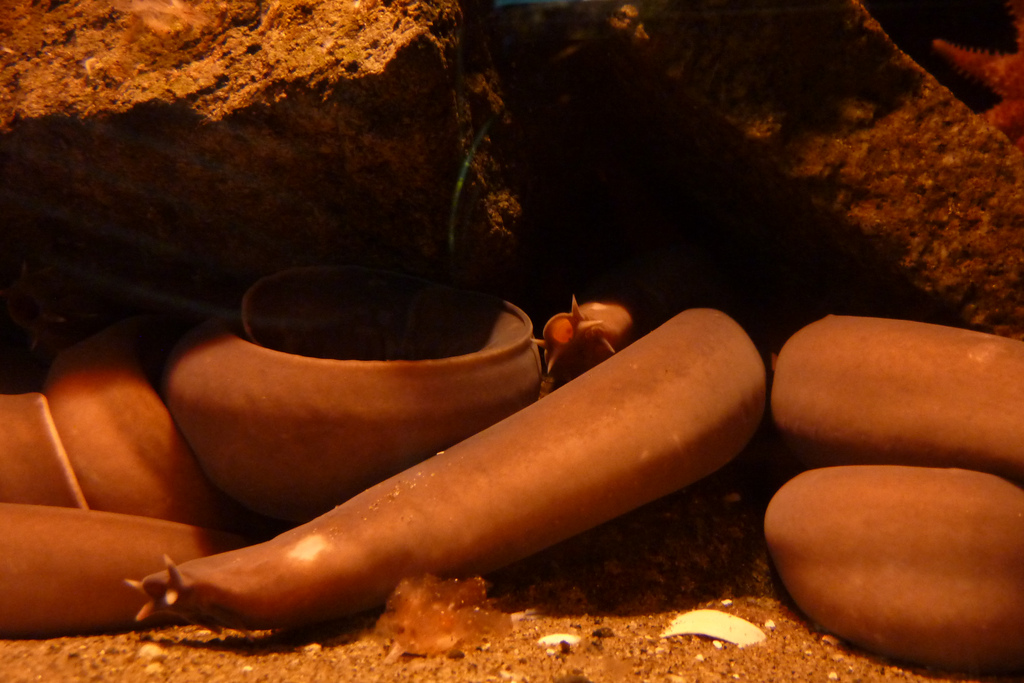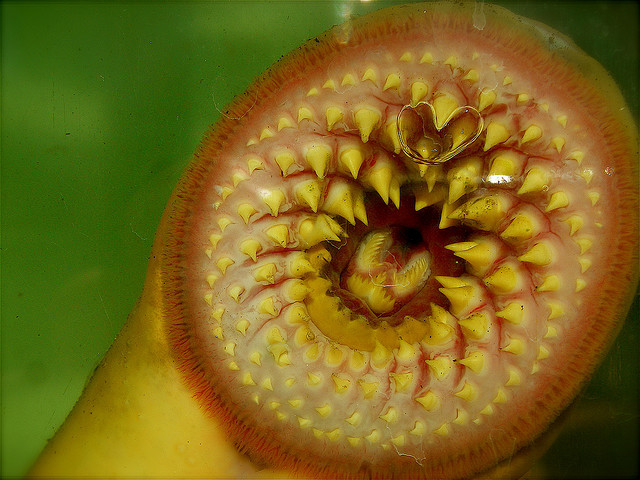
Is it just me or do these guys' snouts have a bit of a star-nosed mole feel? Creative Commons wondoroo
A bit of interesting news this week: the humble and much-reviled hagfish (“disgusting” seems to be its most common moniker) was knocked off its podium at the evolutionary junction between vertebrates and invertebrates.
Perhaps we should begin at the beginning: what is a hagfish? Glad you asked: it’s a serpentine, sea-dwelling, knot-tying, slime making scavenger that lacks vertebrae (a bony spinal column that protects the dorsal nerve cord), compound eyes, or true teeth. It does have a rudimentary skull, but it lacks compound eyes, having instead only simple eyespots. And about that slime: there’s a lot of it, and it’s really noxious. Grabbing a hagfish by the tail will result in a veritable deluge of the sticky, gill-clogging stuff, which may be why hagfish’s only predators are birds and mammals, not fish, and why after sliming themselves, the hagfish has to tie itself in a knot that it works down its body to wipe its own slime off. Some theorize that even the *hagfish* can’t breath through the stuff if they leave it on too long.
Wikipedia drily notes:
An adult hagfish can secrete enough slime to turn a 20 litre (5 gallon) bucket of water into slime in a matter of minutes.
‘Atsa lotta slime.
In any case, for a long time hagfish were apprently classified with the jawless lampreys on the big ‘ol tree of life. They were considered to be the earliest representatives of the vertebrates, from the time before jaws had evolved.
For those of you who might have difficult remembering from high school biology or who have never had the pleasure of seeing one up close, here is a view into the mouth of a lamprey:
Is it just me or does this somewhat horrifying angle resemble this? Lampreys are famous for their parasitic lifestyle: they latch onto the side of fish with their horrible, horrible rows of teeth and suck until they can suck no more. (Possible bionerd bumper sticker idea: Lampreys Suck)
In any case, DNA studies eventually seemed to show that the hagfish actually were more primitive than lampreys, providing the “missing link” between the most complex invertebrates and the most primitive vertebrates — the lampreys. Now new studies of snippets of RNA called microRNA seem to show they are actually as they first seemed: closely related to the much more easy-for-scientists-to-work-with lampreys*.
In all the time scientists were working on hagfish, they were only able to find *three* embryos in the entire 20th century. And if I had to choose between the horrible rows of teeth or the suffocating slime? Teeth. Fo’ sho. Although I have to say the hagfish are cuter. Though admittedly, we’re talking about a pretty low bar here.
———————————————————————————
* For the biologists in the room: microRNAs date me; I cannot recall learning about them in the late 1990s when I was in college, but they are big, apparently, now: very short segments of RNA that latch onto messenger RNAs in the short, untranslated section at their tail ends and turn them off. They are also strongly conserved among species, making them, like ribosomal RNA, great for looking at large-scale evolutionary relationships.



{ 4 comments… read them below or add one }
Oy. In a fit of pique, I once called someone a “hagfish,” the worst insult I could come up with in the moment. Once my non-biologist friends looked up what a hagfish is, they all said I was way out of line, which I had to agree I was.
So, the point of the recent study is that hagfish are not the ancestors of today’s cartilaginous and bony fish? Too bad, I suppose, but at some point, “missing links” have got to be inferred, rather than found. (Especially when those things don’t have bones.) Can’t collect ’em all. If the hagfish isn’t the missing link, I wonder, instead, why the missing link went extinct. Perhaps there was no happy medium between the vertebrate and invertebrate that our jawless fishes couldn’t better exploit? Maybe it pays to choose to have a backbone, or not?
No, it’s just that the hagfish’s take-a-hike point from our last common ancestor is further up the tree than we thought. If they group with the lampreys as we originally though, they still share a common ancestor with us and bony fish, it’s just that there’s now a bigger gap between the branch point of the last common ancestor of today’s most complex invertebrates (amphioxus and tunicates, or sea squirts), and the lamprey-hagfish group. Which doesn’t mean those organisms didn’t exist, just that whatever form they took didn’t stick around.
Maybe whatever intermediate forms existed evolved very quickly from invertebrates to vertebrates, leaving little time to speciate. Your last two hypotheses seem sound to me, too.
One other final delightful hagfish detail I forgot to mention in the main post: the sperm and eggs of hagfish have no special duct to help them on their merry way. Instead, they are released directly into the body cavity of the hagfish, from which they must find their own way out, generally through an opening in the digestive tract, if wikipedia is to be believed. At least sperm can swim, but how on earth do the eggs get out, except maybe by overwhelming force of numbers? Well, on the other hand, perhaps unlike sperm, who are sure they know where they are going, the eggs are willing to stop and ask for directions.
Sure, sure, I didn’t mean to imply they didn’t exist… obviously they did! Only why their tenure on Earth was so brief.
Tunicates have a free-swimming, bilaterally-symmetric larval stage, right? Something like a planktonic tadpole? I have to wonder if the first vertebrates were evolved from the juvenile forms of sessile species, retaining neotenic features and developing a spinal cord while they were at it.
And how do hagfish lay eggs? The same way I presumed babies were born when I was a kid: through their butts.
Yes, that’s right about tunicates. And again, your hypothesis is indeed along the lines of what most biologists suspect.
All I have to say is: glad I’m not a hagfish. : )